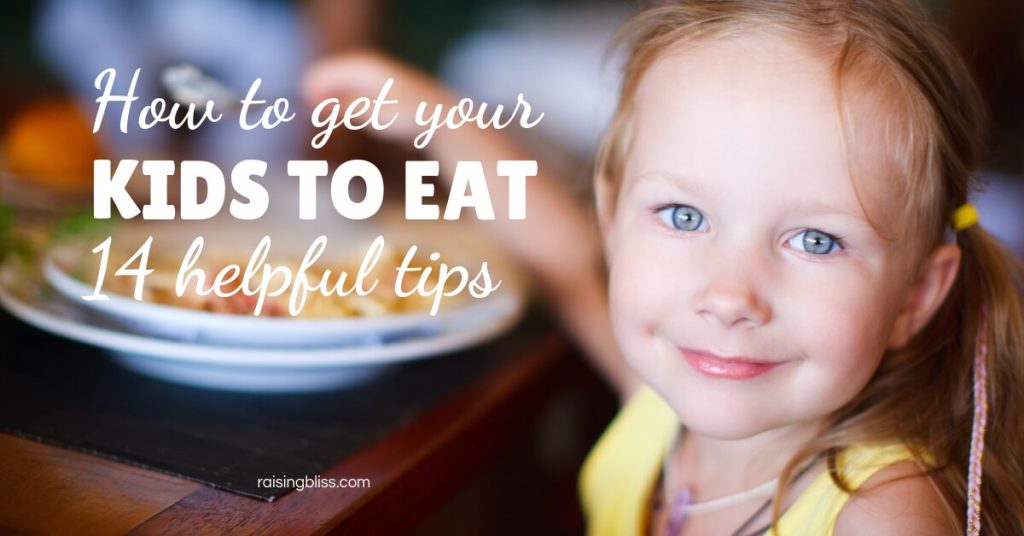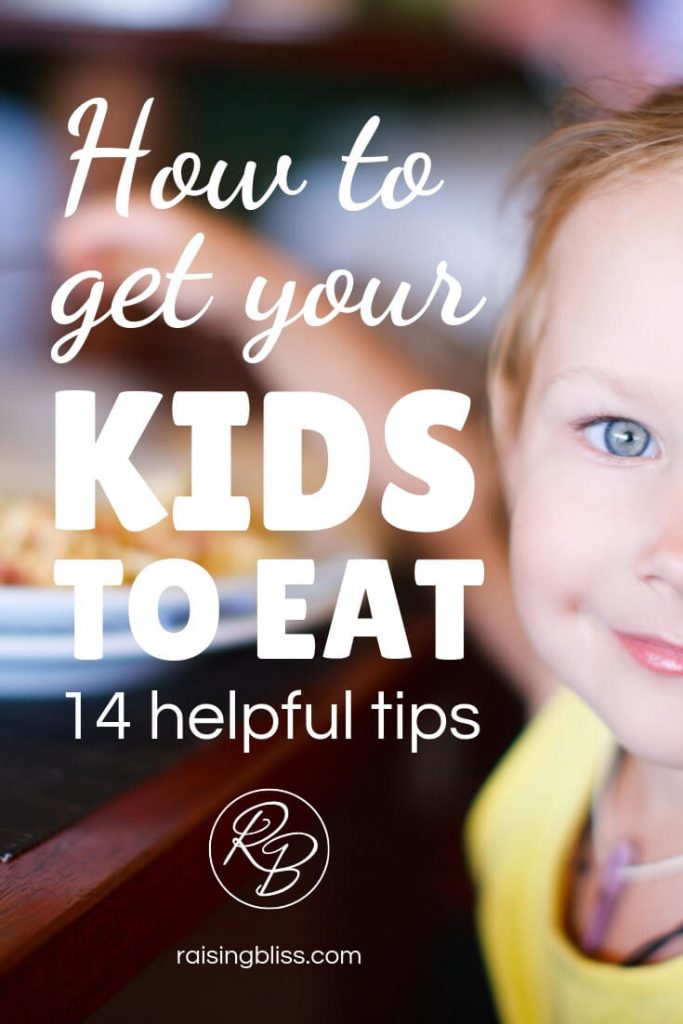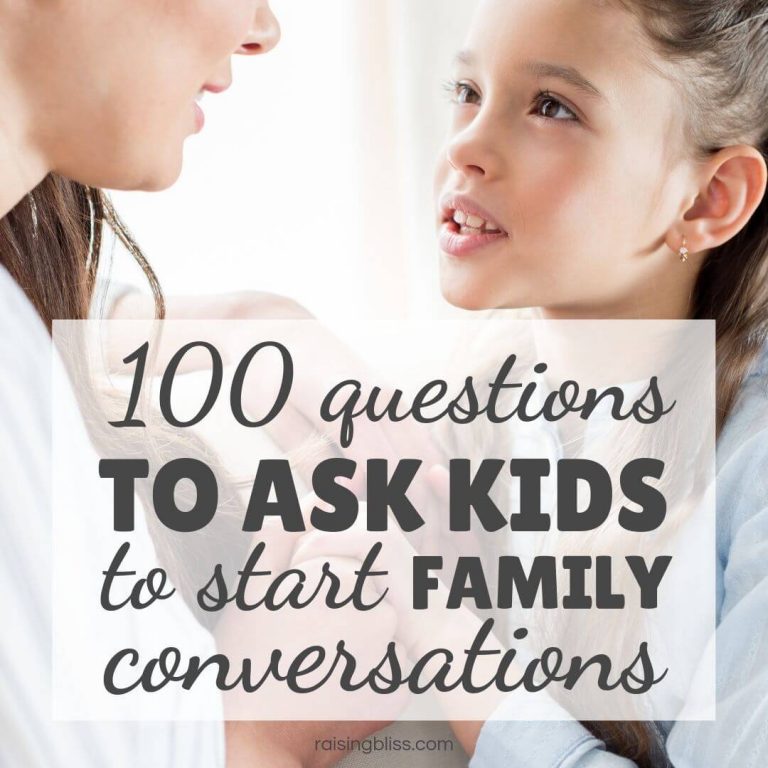How to Get Kids to Eat – 14 Helpful Tips
Dinnertime struggles? Here’s how to get your kids to eat.
WANT TO REMEMBER THIS ARTICLE? PIN IT TO YOUR FAVORITE PINTEREST BOARD!
Picky eaters can turn a perfectly serene dinner table into a war zone. Ask me how I know. Out of our five kids, only two are naturally good at eating new foods, or any foods in general. Of course, everyone has their dislikes, but for the most part, we have two good eaters. For the other three, let’s just say we are improving. So when there’s whining at the table, and kids are pushing away their plates, how do you get your kids to eat their dinner?
You may have been there. You’ve spent an hour at the stove preparing a healthy, delicious meal for your loved ones, and as soon as everyone sits down at the dinner table, you hear, “I don’t want this!”
How my picky eater ate his dinner
I was sitting across my 6-year-old son, looking at his untouched plate of food. He was looking at me, determined to stand his ground. “I’m not eating that!” He said for the twentieth time. “It’s really good, just try it,” I pleaded. “Well, that’s just your opinion,” He said, furrowing his brows.
He was right, it was my opinion. But it was also the opinion of the rest of the family members who were already done with their dinner. “I’m not eating it!” He repeated passionately. I was tired of arguing with a little person, so I said, “Ok, you don’t have to eat it. But you’re not getting anything else.”
He sat back in his chair, crossed his arms, and gazed at me from under his eyebrows, looking very unhappy. I turned to clean the table. I moved all the dishes to the sink and went on loading the dishwasher. After the last plate was loaded, I washed my hands, turned off the faucet, and turned around to wipe the table clean.
My son was standing right behind me, holding an empty plate. I took the plate from his hands, and asked, “How was it?” He looked down at his feet, then looked at me and said, “It was really good, mama.”
How to Get Kids to Eat
As moms, we want our kids to be happy and healthy, to be fed and warm, and to have peace in the house and our family. But if you have a child that will not eat their dinner, it’s hard to have a peaceful time with family at the dinner table.
Whether you have a toddler, a preschooler, or a school-aged child, these ideas may help with dinner time battles. Let’s take a look at 14 tips for how to get kids to eat their dinner.
1. Limit snacks
Your child will be more likely to refuse their dinner if they’re not hungry. Limit their snacks throughout the day, and don’t let them have any at least 1.5 hours before dinner. If he’s just had a snack, and there is a plate of “questionable matter” in front of him (also known as very delicious dinner), he will be more likely to refuse to eat it.
I have learned that hungry kids will eat anything. I’m not suggesting famine throughout the day just so they’ll be hungry enough to eat anything you give them but limiting their snacks 1.5 hours before dinner will help.
2. Ask their opinions beforehand
Ask them what they want for dinner. Of course, if you just ask, “What do you want for dinner?” They’ll probably answer, “Pizza” or “Mac-n-cheese”. Don’t do it, it will create tension when you try to convince them that eating pizza every day is not the best nutritional choice.
Instead, give them two choices. “Do you want chicken soup or grilled chicken and veggies for dinner?” Make sure both choices are perfectly fine with you. When kids are involved in the decision-making process, they’re less likely to complain about what’s on the table.
If you have more than one child and they want different things, ask them to talk among themselves and decide. Give them a time limit of 2-5 minutes (you can set a kitchen timer for this). Make sure they know that if they will not come up with a decision when the time is up, you will decide for them.
Sometimes this works, and sometimes you’ll still be the decision-maker. But it’s important to give your kids this option to keep them involved in making a dinner decision.
3. Let them cook with you
This was gold for one of my boys. When he was four, he wanted to help me cook dinner and asked to peel the potatoes. My initial thought was, “There’s no way I’m giving him a potato peeler! His fingers are so tiny, he’ll slice them right off.”
But I did it anyway. I knew that it was important to let kids help when they want to help. So I showed him how to do it, gave him a potato and a peeler, and watched him like a hawk. He tried to make that first slice as I repositioned his fingers in an effort to keep them safe from the blade.
The first few tries, it didn’t work. He kept trying, and finally, he peeled a thin slice off. He looked up at me, grinned, and kept going. As he worked, I stood next to him, peeling the rest of the veggies. It took him about 20 minutes to peel his first potato, and when he was done, we celebrated. I cheered and jumped, and he was happy as a clam.
His peeled potato didn’t look like mine. The buds were still in it, and there were traces of some potato skin still left on it. But it was a celebratory potato. My son ate his dinner like a champ that evening.
To this day, he is my go-to potato peeler. At seven years old he is much quicker now, and when I need help, he’s (usually) very willing to lend me a hand.
If your child expresses interest in helping you cook dinner, let them. Even if it’s something small, like adding a previously measured ingredient to the pot, or watching you peel the carrots. Give them a chance to mix the ingredients together or pass to you the utensils you need.
When you get help from them, make sure they know how much you appreciate it. Let them get hands-on with the dinner process, and they will be less likely to be fussy during dinner time. To motivate them to eat, say words like, “We cooked dinner together, let’s see how delicious it turned out!”
4. Go easy on yourself
Unless you have a child with food allergies, prepare the same meal for all family members. Avoid cooking separate meals based on what each of your kids want. If you do, it’s a sure way to a quick burnout. Be kind to yourself and avoid the extra pressure of cooking several meals in a single day.
5. Avoid conflict
There is a small exception to tip number 4 above. If you know your child absolutely refuses to eat squash and always did, don’t serve it to him. Add broccoli to his plate instead.
This seems to contradict the above tip, but if it’s not too much trouble to add the broccoli to the steamer where the squash is cooking, do it in the name of peace at the table. Just don’t let it become time-consuming on your part.
6. Make it fun
If you have the time and your child is into eating art, arrange food on your child’s plate into a scenery. Or, simply have a special plate just for dinner. Have your child pick out a fun plate the next time you’re at the store, and use it just for dinner, just for her.
7. Encourage
Kind and encouraging words go a long way with kids. Say things like, “You’ll grow so big and strong, soon enough you’ll be carrying mommy around!” Or “Great job eating your dinner, I can already see those muscles growing, whoa!” Kids like the idea of growing big, and phrases like these will motivate them to finish what’s on their plate.
8. Avoid overwhelm
When introducing new foods, don’t make a whole meal out of ingredients that are new to your child. Add one new item to her plate and encourage her to try it. If she refuses, she will have other foods on her plate that she knows and can eat without overwhelm.
9. Eat it together
If your child is young enough for this tip, try to motivate her to get a bite together with you. Say, “Let’s do it together, I’ll take a bite, and you take a bite. Ready? One, two, bite!”
Side note. Don’t turn dinner time into a competition. Avoid “races” and saying, “Let’s see who will finish their dinner first.” If your child is competitive, this might be a problem, as they can swallow their food without chewing properly.
10. Stand your ground
In an effort to teach your kids to eat what’s on the table, avoid letting them dig through the fridge or worse, the snack cabinet during dinner time. Encourage them to eat what you cooked. They don’t want rice? Fine, they can eat chicken and veggies. As long as they eat what’s on the table and don’t go searching for something else, it’s a step in the right direction.
11. Negotiate
It’s ok to compromise sometimes. If your child ate a little and doesn’t want to eat anymore, try to negotiate. “If you don’t want to finish your dinner, just take five more spoonfuls, and you’ll be free to go.” Make sure you’re ok with this compromise before offering it and stick to your word.
12. Use rewards
Offer an after-dinner treat to your kids if they eat their food. If you allow ice-cream or other desserts, this can motivate them to finish their dinner.
If your child refuses to eat and cries, “But I want ice-cream now!” Avoid saying “No” or “You can’t”. Instead, say, “You CAN have ice-cream AFTER you eat your dinner.” This puts an emphasis on how your son can get what he wants, and will help with avoiding the drama that sometimes results after hearing “No”.
13. Give them space
Don’t hover over your child and remind him every 10 seconds that he needs to take another bite. Give him space, and if you’re done with your dinner, step away and give him a chance to eat in peace. This doesn’t work for all kids. If you have a daydreamer that gets distracted easily, you may need to gently remind him that he’s eating dinner and not playing outside with rocks at the moment.
14. Don’t force
Don’t make your kids eat. If after trying the above tips your child still doesn’t want to eat his dinner, let him leave the table. Before he does, tell him that if he comes back into the kitchen looking for something to eat, his dinner plate will be waiting for him.
If he returns for a snack, point him to his plate. Warm it up if needed. Work with him. But make sure to stick to your word. Your job here is to get the message across that you’re serious about dinner.
What if you have a strong-willed child and he would rather go to bed hungry than eat his dinner? This worried me too. I wasn’t brave enough to let my kids go to sleep hungry, but my husband knew the importance of this lesson, and one evening he sent two of our boys to bed hungry.
And guess what? They didn’t die. The next morning, they ate their breakfast like champs.
Take baby steps to Peaceful Meals
Some of these tips will work for kids in certain age groups, so if you try a tip and your child is unamused, try another one. The point is to try your best to help them do their best to eat the healthy dinner you’ve prepared for them.
Teaching your kids to eat what’s on their plate is a part of helping them build healthy eating habits. This process will take time, and your child will most likely not become an overnight magical being that eats everything you give him. Keep trying to teach your kids how to eat their dinner and the result will be peaceful mealtimes where the family talks about their day, and everyone eats without dinner time battles.









